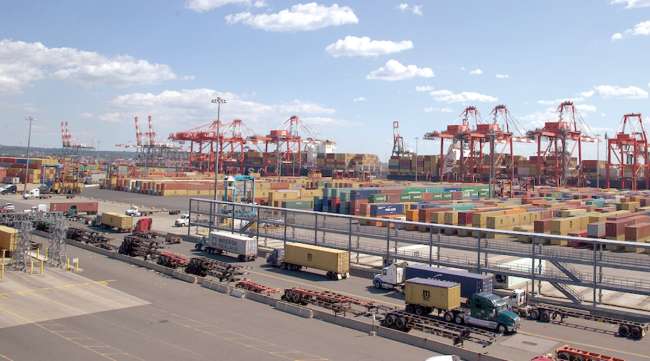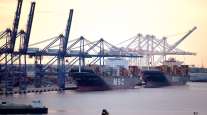Senior Reporter
East Coast Ports Continue to Assess Damage From COVID-19

[Ensure you have all the info you need in these unprecedented times. Subscribe now.]
The nation’s East Coast ports continued to be battered by lower imports from overseas in June, just as their West Coast counterparts have been because of the COVID-19 pandemic.
The Port Authority of New York and New Jersey, which operates the nation’s busiest facility on the East Coast, told Transport Topics on Aug. 8 it had a 16.3% year-over-year drop when it processed 511,306 industry-standard 20-foot-equivalent containers during that month. In June 2019, the facility moved 611,027 TEUs.
In addition to its port facilities, the Port Authority operates six airports in the New York/New Jersey area, the PATH rapid transit system, and numerous tunnels, bridges and rail yards. The Port Authority does not receive direct government aid but relies on fees it charges its business partners to cover its operating budget.
However, it is seeking $3 billion in federal assistance as it anticipates ongoing damage.

O'Toole
“Due to the global pandemic, Port Authority revenues were down nearly $800 million just through June of this year — an unprecedented number for this agency,” Chairman Kevin O’Toole said. “This region has been hard hit by the pandemic, and the Port Authority was not immune. Without federal assistance, the Port Authority and the region will be forced to feel the weight of this loss for years to come.”
New York/New Jersey officials recently announced they have cut $200 million in spending and continue to assess other reductions.
American Association of Port Authorities CEO Chris Connor told TT that facilities on both coasts are struggling with deep cuts in cargo and loss of revenue.

Connor
“I think the port community has figured out to the best of their ability over the last four or five months how to operate with less,” Connor said. “They’ve taken all the moves that any business would take on to reduce costs and still … deliver for the overall economy.”
But, Connor said, many ports could begin cutting or deferring long-term capital improvements such as dredging and purchasing new cranes and other equipment because of the downturn in the economy.
Georgia’s Port of Savannah, which set monthly container volume records in 2019, saw a 6.3% drop in container volume in June as it moved 338,917 TEUs, compared with 361,906. At the halfway point of 2020, the port topped its 2019 monthly numbers only once, in February, when it moved 16.7% more containers than in 2019.
Port officials announced July 27 that it finished FY2020 having 4.44 million TEUs, which is down less than 1% compared to the previous year. The port is also going ahead with its multibillion-dollar expansion plan, intending to double its capacity by the end of the decade.
“What sets Savannah apart from the competition is the sheer capacity of the port’s ever-expanding footprint, on and off the terminal,” Port Chairman Will McKnight said. “Not only are we focused on the future and providing even greater value to our customers, but we have nearly unlimited potential and capacity to grow our business.”
South Carolina Ports Authority, which operates the Port of Charleston, saw a 21.9% drop in container volume as it processed 156,494 units in June compared with 200,406 in the same period a year ago. While the numbers are down, port officials announced July 20 that Walmart plans to build a $220 million, 3 million-square-foot distribution center near Ridgeville, which is about 40 miles from the port. Once fully operational, the facility is expected to increase volumes at the Port of Charleston by about 5%.
The Port of Virginia saw volume decline 11.9% in June, to 210,660 TEUs from 239,329 a year earlier. The end of June marks the close of fiscal 2020, and port officials said volume declined 6.2% during the 12 months. For the year, the port moved 2.25 million containers.
As we looked more closely at the work we did prior to and during the pandemic, and outside of our normal metrics, we came away with a unique picture of success in a year of obstacles.
John Reinhart, Port of Virginia CEO, on fiscal 2020 for the port
“Accurately measuring the results of a year turned upside down by a pandemic is a significant challenge,” CEO John Reinhart said. “Total cargo volume and revenue are our usual primary metrics, but to get a true picture of what was accomplished in FY20, it is important to take into account our accomplishments beyond the numbers.
“As we looked more closely at the work we did prior to and during the pandemic, and outside of our normal metrics, we came away with a unique picture of success in a year of obstacles.”
Port Houston saw a 16.1% decrease in container volume in June. The port processed 210,932 containers, compared with 251,488. Port officials said they are cautiously optimistic.
“It is impossible to predict at this point how long these trends will continue,” Executive Director Roger Guenther said. “However, we continue to plan for the future. I am confident that our resilient economy, and the cargo exported and imported, will rebound quickly in our region when the pandemic begins to ease.”
Want more news? Listen to today's daily briefing:
Subscribe: Apple Podcasts | Spotify | Amazon Alexa | Google Assistant | More





